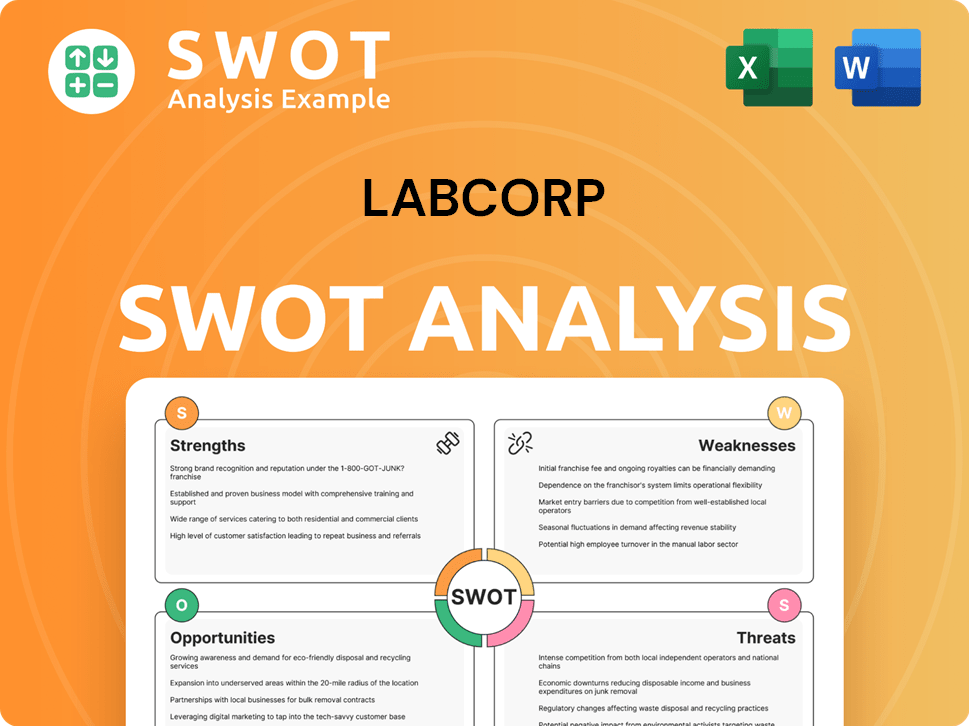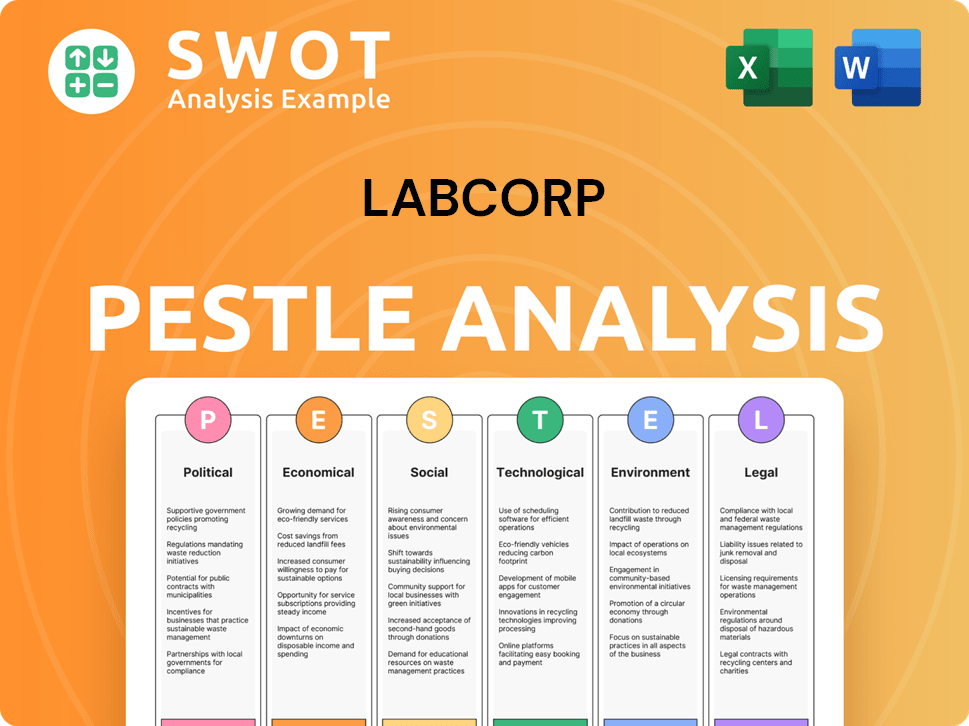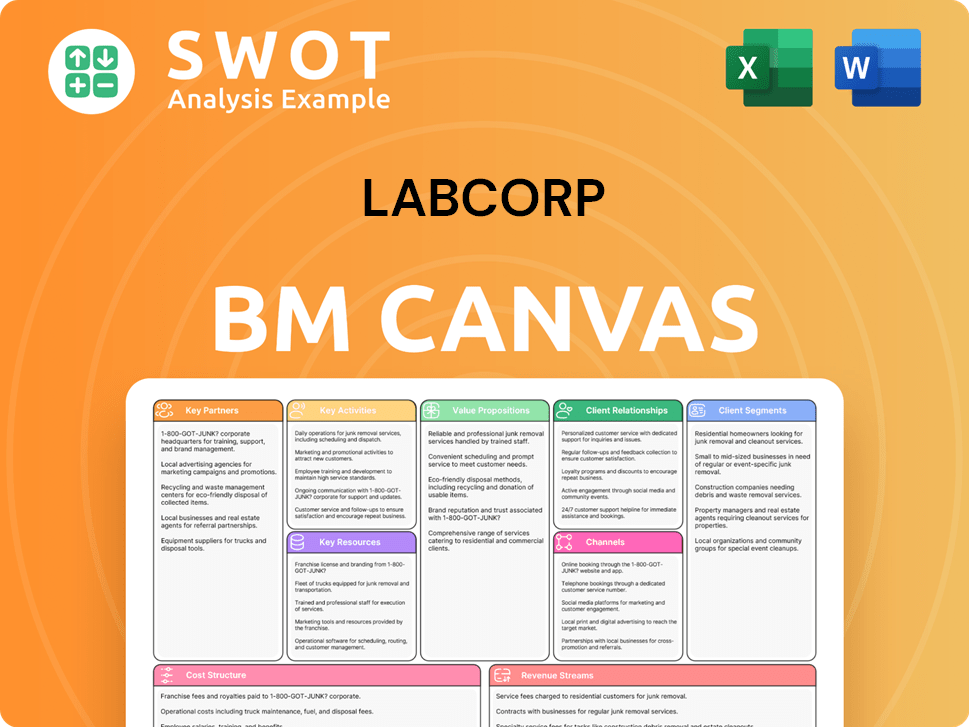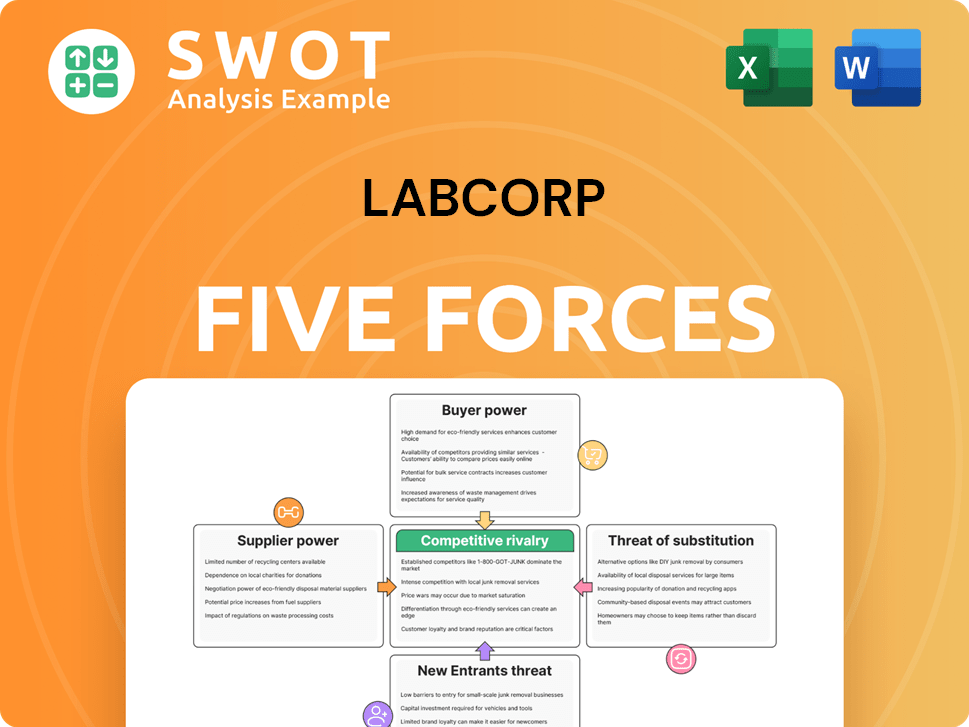Labcorp Bundle
Who Really Controls Labcorp?
Understanding the Labcorp SWOT Analysis is just the beginning; the true power lies in knowing who owns Labcorp. From its humble beginnings to its current status as a global healthcare leader, Labcorp's ownership structure has evolved significantly. This exploration unveils the key players influencing Labcorp's strategic direction, market position, and future prospects.

Delving into the details of Labcorp's ownership provides critical insights for investors, analysts, and anyone interested in the Labcorp company. This analysis will cover the company's origins, tracing its journey from its founding in 1969 as Biomedical Laboratories by Dr. James B. Powell and his brothers, to its present-day structure. We will examine the influence of major shareholders, the role of the board of directors, and the impact of these factors on Labcorp's overall performance and strategic decisions, including its relationship with Covance.
Who Founded Labcorp?
The genesis of the company now known as Labcorp traces back to 1969, with the establishment of Biomedical Laboratories. The founders, Dr. James B. Powell and his brothers, Dr. Thomas Edward Powell III and John Powell, initiated the company. Their vision was to improve the efficiency of laboratory testing, a need Dr. James Powell recognized in the 1960s.
Initially, the company operated from a modest location: the basement of the former Alamance General Hospital in Burlington, North Carolina. This humble beginning marked the start of what would become a major player in the diagnostics and healthcare industry. Biomedical Reference Laboratories went public in 1979, which was a pivotal moment in its early development.
A significant transition occurred in 1982 when Hoffman-Roche acquired Biomedical Reference Laboratories. The company was then renamed Roche Biomedical Laboratories. Dr. Powell continued to lead as President and CEO, overseeing the integration of the merged entities. While specific details on the initial equity distribution among the founders are not publicly available, their leadership was essential to the company's early success.
Biomedical Laboratories was founded in 1969 by Dr. James B. Powell and his brothers.
The company went public in 1979, marking a key step in its expansion.
In 1982, Hoffman-Roche acquired the company, leading to a name change to Roche Biomedical Laboratories.
Dr. James Powell remained as President and CEO after the acquisition, ensuring a smooth transition.
The company started in the basement of a hospital in Burlington, North Carolina.
The initial focus was on improving the efficiency of laboratory tests.
The early history of the company, now known as Labcorp, is marked by its founding by the Powell brothers, its initial public offering, and its acquisition by Hoffman-Roche. These events shaped the company's trajectory and established its presence in the healthcare sector. For more insights into the company's strategic direction, consider reading about the Growth Strategy of Labcorp.
- The company's origins lie in Biomedical Laboratories, established in 1969.
- It went public in 1979, expanding its financial base.
- Hoffman-Roche's acquisition in 1982 was a pivotal moment.
- Dr. James Powell's continued leadership ensured operational continuity.
Labcorp SWOT Analysis
- Complete SWOT Breakdown
- Fully Customizable
- Editable in Excel & Word
- Professional Formatting
- Investor-Ready Format

How Has Labcorp’s Ownership Changed Over Time?
The evolution of Labcorp's ownership is marked by its transformation into a publicly traded entity. The merger of Biomedical Reference Laboratories and National Health Laboratories in May 1995 formed Laboratory Corporation of America, now known as Labcorp Holdings Inc. This strategic move, alongside the relocation of its headquarters to Burlington, North Carolina, set the stage for its future as a major player in the healthcare industry. The company is listed on the New York Stock Exchange under the ticker LH, which allows for public investment and influences its ownership structure.
As a publicly traded company, the
Labcorp ownership
is primarily held by institutional investors. This structure has a significant impact on the company's strategic direction and governance. The shift to public ownership brought in a diverse group of shareholders, each with their own interests and expectations regarding the company's performance and growth. This diversification has helped shape Labcorp's approach to market dynamics and its overall business strategies.| Shareholder | Shares Held (as of March 31, 2025) | Percentage of Ownership (Approximate) |
|---|---|---|
| Vanguard Group Inc. | 9,722,508 | Data not available |
| BlackRock, Inc. | 9,277,513 | Data not available |
| State Street Corp. | 3,827,036 | Data not available |
The significant holdings by institutional investors, such as Vanguard Group Inc., BlackRock, Inc., and State Street Corp., underscore their confidence in the company. The institutional ownership, standing at nearly 96% as of March 31, 2025, highlights the stability and attractiveness of Labcorp as an investment. The influence of these major shareholders, alongside individual investors and company executives, is a key factor in shaping Labcorp's strategic decisions and its overall performance. Labcorp's financial performance in 2024, with a revenue of $13.01 billion, and a projected revenue range of $13.88 billion to $14.05 billion for 2025, reflects the company's appeal to its stakeholders.
The
Labcorp owner
structure is primarily influenced by institutional investors, holding a significant majority of the shares.- Institutional ownership is nearly 96% as of March 31, 2025.
- Major shareholders include Vanguard Group Inc., BlackRock, Inc., and State Street Corp.
- The company's financial performance and strategic direction are significantly influenced by these major stakeholders.
- Labcorp's revenue for 2024 was $13.01 billion, with a projected revenue range of $13.88 billion to $14.05 billion for 2025.
Labcorp PESTLE Analysis
- Covers All 6 PESTLE Categories
- No Research Needed – Save Hours of Work
- Built by Experts, Trusted by Consultants
- Instant Download, Ready to Use
- 100% Editable, Fully Customizable

Who Sits on Labcorp’s Board?
The current board of directors at Labcorp plays a significant role in the company's governance and strategic oversight. The board's composition includes a mix of independent directors and those with executive roles within the company. Adam H. Schechter serves as the President and CEO of Labcorp. Paul B. Rothman has served as a director since June 6, 2023, and as Chairman of the Quality and Compliance Committee since June 2024.
The board's decisions are crucial for the company's direction, including leadership changes and strategic initiatives. The board’s actions are vital for maintaining the company's competitive position and ensuring long-term value for shareholders. For more information about the company, you can read a Brief History of Labcorp.
| Board Member | Role | Date Joined |
|---|---|---|
| Adam H. Schechter | President and CEO | N/A |
| Paul B. Rothman | Director, Chairman of the Quality and Compliance Committee | June 6, 2023 |
Labcorp operates under a one-share-one-vote structure, which is common among publicly traded companies. This means that each common share generally carries one vote. There are no indications of dual-class shares or special voting rights that would give outsized control to specific individuals or entities. Shareholder proposals are part of the governance landscape, with the company sometimes omitting such proposals under specific SEC rules. For example, a proposal submitted by United Church Funds in March 2025, requesting a lobbying report, was omitted.
Understanding Labcorp ownership involves looking at the board of directors and voting rights. The board includes independent directors and executives like the President and CEO. The company uses a one-share-one-vote system, ensuring fair voting power for all shareholders.
- The board oversees strategic decisions and leadership changes.
- Shareholder proposals are part of the governance process.
- The company structure supports equal voting rights for shareholders.
- Recent leadership changes reflect board influence.
Labcorp Business Model Canvas
- Complete 9-Block Business Model Canvas
- Effortlessly Communicate Your Business Strategy
- Investor-Ready BMC Format
- 100% Editable and Customizable
- Clear and Structured Layout

What Recent Changes Have Shaped Labcorp’s Ownership Landscape?
Over the past few years, the ownership landscape of the company has been marked by strategic moves and a focus on shareholder value. In 2024, the company reported a full-year revenue of $13.01 billion, with a projected revenue range of $13.88 billion to $14.05 billion for 2025, indicating continued growth. The company has also actively repurchased shares and paid dividends, reflecting its commitment to returning value to shareholders. For instance, in Q4 2024, the company repurchased $75.1 million in shares, with approximately $1.3 billion still authorized for buybacks. In the first quarter of 2025, the company paid out $62 million in dividends.
The company has been actively involved in mergers and acquisitions to bolster its market position, with several key acquisitions completed or announced recently. These include the acquisition of select assets from Providence Health & Services in March 2024, an agreement with MAWD Pathology Group in December 2024, and an agreement in Q1 2025 to acquire select assets of BioReference Health's oncology and related clinical testing services businesses. These acquisitions are anticipated to drive top-line growth. Additionally, the company completed the acquisition of North Mississippi Health Services' ambulatory outreach laboratory business in Q1 2025. These strategic moves suggest a dynamic approach to expanding its service offerings and market reach. You can find more insights in the Marketing Strategy of Labcorp.
| Metric | Details | Year |
|---|---|---|
| Full-Year Revenue | $13.01 billion | 2024 |
| Share Repurchases (Q4) | $75.1 million | 2024 |
| Dividends Paid (Q1) | $62 million | 2025 |
| Institutional Ownership | Nearly 96% | March 2025 |
The company's leadership has also seen changes, with Julia Wang taking over as Executive Vice President and Chief Financial Officer in December 2024, and Bola Oyegunwa joining as Executive Vice President and Chief Information and Technology Officer in November 2024. These changes, along with the company's focus on strategic acquisitions and expansion into high-growth areas, suggest a forward-looking strategy aimed at sustained growth and market leadership. Institutional investors hold nearly 96% of its shares as of March 2025, reflecting confidence in the company's future.
Acquisition of select assets of BioReference Health's oncology and related clinical testing services businesses for up to $225 million, expected to close in the second half of 2025.
Share buybacks in Q4 2024 totaled $75.1 million, with approximately $1.3 billion still authorized for buybacks, and $62 million in dividends paid in Q1 2025.
Executive Vice President and CFO Glenn Eisenberg retired on April 30, 2025, with Julia Wang taking over in December 2024, and Bola Oyegunwa joining as Executive Vice President and Chief Information and Technology Officer in November 2024.
Institutional investors hold nearly 96% of its shares as of March 2025, reflecting strong confidence in the company's strategic direction and financial performance.
Labcorp Porter's Five Forces Analysis
- Covers All 5 Competitive Forces in Detail
- Structured for Consultants, Students, and Founders
- 100% Editable in Microsoft Word & Excel
- Instant Digital Download – Use Immediately
- Compatible with Mac & PC – Fully Unlocked

Related Blogs
- What are Mission Vision & Core Values of Labcorp Company?
- What is Competitive Landscape of Labcorp Company?
- What is Growth Strategy and Future Prospects of Labcorp Company?
- How Does Labcorp Company Work?
- What is Sales and Marketing Strategy of Labcorp Company?
- What is Brief History of Labcorp Company?
- What is Customer Demographics and Target Market of Labcorp Company?
Disclaimer
All information, articles, and product details provided on this website are for general informational and educational purposes only. We do not claim any ownership over, nor do we intend to infringe upon, any trademarks, copyrights, logos, brand names, or other intellectual property mentioned or depicted on this site. Such intellectual property remains the property of its respective owners, and any references here are made solely for identification or informational purposes, without implying any affiliation, endorsement, or partnership.
We make no representations or warranties, express or implied, regarding the accuracy, completeness, or suitability of any content or products presented. Nothing on this website should be construed as legal, tax, investment, financial, medical, or other professional advice. In addition, no part of this site—including articles or product references—constitutes a solicitation, recommendation, endorsement, advertisement, or offer to buy or sell any securities, franchises, or other financial instruments, particularly in jurisdictions where such activity would be unlawful.
All content is of a general nature and may not address the specific circumstances of any individual or entity. It is not a substitute for professional advice or services. Any actions you take based on the information provided here are strictly at your own risk. You accept full responsibility for any decisions or outcomes arising from your use of this website and agree to release us from any liability in connection with your use of, or reliance upon, the content or products found herein.